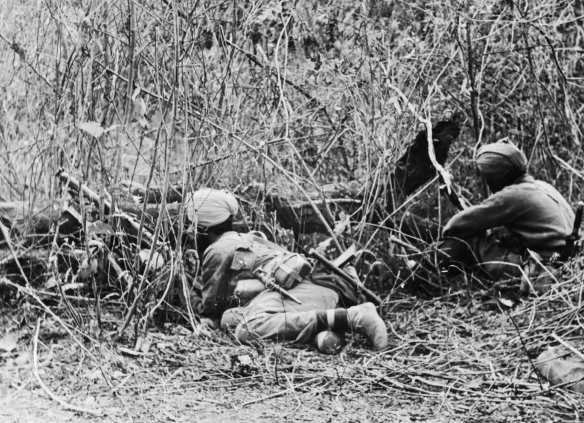
Slim, who used to post photographs above his desk of the Japanese commanders he faced so that he might gain insight into their psychology by studying their faces, had always expected a counterattack against 15 Corps. Indeed, he had worked out that the blow was almost certain to fall on the flank of 7 Indian Division on the left. But when the Japanese did launch their counterattack, he was taken aback by its size and the sheer speed of the enemy. Where Slim had been tempting his foe to battle for his own short-term purposes, the Japanese counterpunch was part of a long-term, almost geopolitical objective. As some of Wingate’s critics had feared, the main consequence of Operation LONGCLOTH was that it gave the Japanese ideas of their own and specifically raised the idea of an attack on India. Lieutenant General Mutaguchi Renya, victor of the Singapore campaign in 1942 and now commander in Burma, wargamed the possibility of an attack on India and won the support of his superiors in Tokyo. His thinking was that if he could brush past the British in Assam and thus reach the gateway into the subcontinent, all India would rise up to greet their deliverers, led by the pro-Japanese Subhas Chandra Bose and his so-called Indian National Army. The fall of India would mean the definitive end of the British Empire in Asia and would even allow the Japanese to link up with the Russians in Persia. It must be said in passing that the Japanese geopolitical perspective was chimerical, for what was feasible in 1942 was, by 1944, after Stalingrad and Kursk, no longer so; by now the Germans were fighting for survival. Nonetheless, at the very moment Churchill was assuring Wavell that the Japanese would never invade India, Mutaguchi intended to achieve exactly that. Lieutenant General Hanaya Tadashi, commanding in the Arakan, was the stereotypical brutal Japanese officer of legend. His task was to make the British think that the counterattack in the Arakan was the appearance of the main army earmarked for the conquest of India, thus leading Slim to send up his reserves from Imphal. The operation in the Arakan was codenamed HA-GO and was intended as a feint to mask the real attack on Imphal, designated Operation U-GO. To mask U-GO convincingly, the assault in the Arakan had to be massive, and it was this that initially wrong-footed Slim.
Faced with such huge and unexpected numbers, Messervy, commanding the British rear, withdrew into the Admin Box and 7 Indian Division dug itself in for what everyone knew would be a brutal, slugging encounter. Slim had no choice but to commit his reserves at Imphal to Arakan, but still hoped he could use them as the hammer if the Admin Box could hold out and provide the anvil. For 18 days battle ebbed and flowed around the Admin Box but the Japanese could make little impression, despite ferocious hand-to-hand fighting. They had expected that once the British saw their communications severed by the outflanking movement on their left, they would panic and flee, allowing the Japanese to pick off individual regiments at will and thus destroy the whole of 15 Corps. Instead, morale held and the British dug in and waited for a relieving force. And now the scale of Japanese underestimation of the enemy became clear. Their arrogance and overconfidence was truly astonishing; it was almost as though they found it inconceivable that the British army could ever change its methods or tactics or that they might be facing an entirely different kind of opponent this time. Expecting to wind up the Arakan campaign in a mere 10 days, instead for 18 days they beat like oceanic waves against a towering cliff. Attacked by infantry and from the air, the garrison in the Admin Box never wavered, although casualties were terrific; the Box was so crammed with men and materiel that it was almost impossible for attackers not to find a target. The Japanese came closest to success right at the beginning of the siege, when they broke into the hospital compound and shot or bayoneted many of the sick; when they were finally cleared out on 9 February, the bodies of 31 patients and four doctors were found. The ferocity of the Japanese is explicable, though not pardonable, by their awareness of fighting the calendar as well as the British. Too late they realised the appalling risks they had been running with their chimerical 10-day timetable. Everything had been predicated on travelling light and seizing what they needed, but when the British did not roll over as expected, starvation loomed for the poorly supplied attackers. Moreover, casualties began to mount exponentially. Yet as Slim had predicted, the Japanese refused to admit defeat and instead redoubled their effort. By 13 February Slim was confident of victory and soon 26 Indian Division began to arrive to deliver the blow from the hammer. The Japanese fought desperately during the final battles for the Box on 17–24 February, but when they withdrew they left behind them 5,000 dead.